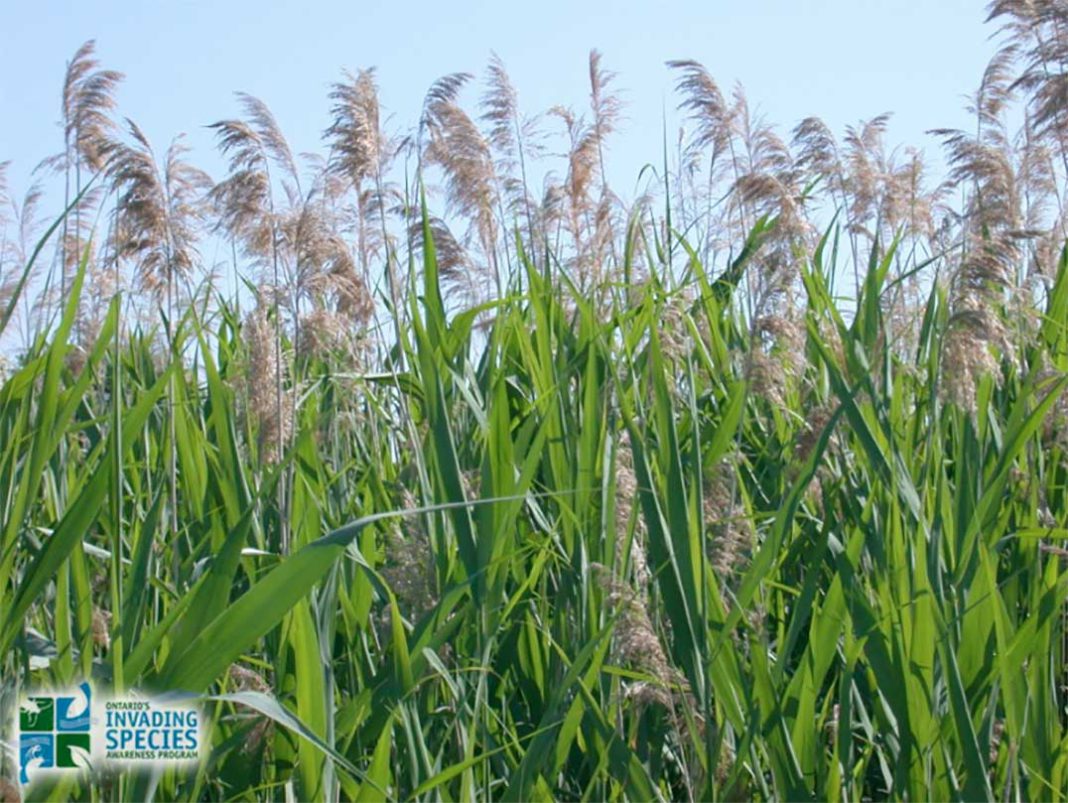by Betty Bardswich
PROVIDENCE BAY—Perhaps one of the nastiest words people have been hearing lately is phragmites. Known as European common weed and phragmites australis, this tall grass-like plant is raising havoc across Canada including Manitoulin.
An information session was held at the Providence Bay community hall on August 9 to outline the destructive nature of this plant. Judith Jones, an environmental consultant from Sheguiandah, and Dr. Janice Gilbert, a wetland ecologist, spoke of the negative impacts phragmites are causing and talked of the solutions to eradicate it.
Ms. Gilbert began to track the plant in 2011 and said, “Phragmites are a very serious issue and is Canada’s worst invasive plant and is happening all along Lake Huron and Lake Erie shorelines. They are found everywhere except Antarctica.”
Ms. Gilbert explained that these plants spread from seeds and predominately underground through rhizomes and that there can be 20,000 seeds on a phragmite head. The parent stalk has more than one stalk out of it, it does well in ditches and the ph of an area does not matter. It is a strong competitor for nutrients and is allelopathic, meaning it exudes chemicals from its roots that harm other plants. “There is nothing in the landscape to stop them except us.” Ms. Gilbert noted, “You can see the Great Lakes are in trouble and this is a big problem for farmers in southern Ontario. Agricultural drainage ditches are full of this plant.”
Ms. Gilbert outlined other concerns, including the loss of recreational opportunities, a negative impact on tourism, a decline in shoreline and also in property values. Other hazards are the blocking of views at intersections, a significant fire hazard and a noteworthy reduction in biodiversity with turtles being particularly susceptible.
There are no natural controls to eradicate phragmites, but three management options were put forth including biological, manual and chemical controls. Ms. Gilbert introduced the audience to the work of Bernd Blossey an ecologist and assistant professor at Cornell University who has an ongoing project titled: ‘Developing Biological Control of Phragmites Australis.’
As far as manual controls, there are several, including covering and smothering the plants, drowning them, cutting below the water line, which is not a fix, but cutting in July can help. There is also spading and Ms. Gilbert mentioned that the Georgian Bay Forever group of cottagers are working on their lots to remove the plants.
Wherever there are thousands of acres of pragmites, Ms. Gilbert spelled out that there are effective chemicals that can be applied, either by handwicking in which a chemical is applied directly to plants or, an emergency use, the chemicals that the United States does and apply airily. A site specific approach must be used. The removal of the biomass means the improvement of native plant and species response.
“We are at the crossroads,” Ms. Gilbert told her audience. “We are in serious trouble as phragmites are moving north. We need to get a concerted effort going. If we don’t destructive activities will become more prevalent.” She went on to list several key components that are needed including the use of proper herbicides, public education, sufficient funds for at least 10 years from all levels of government, locally driven efforts that focus on a watershed scale and a management plan, and a province wide effort. “You are in a great position on the Island to eradicate this,” she added.
Ms. Jones began her talk by saying that she received a little bit of money in 2015 to cut back the perennial grass, but realized it was too much for her. She wrote a paper to ask for help and now has hired three people and had monies for backpacks and other items. “This is a large, large grass,” she said. “Grass on a beach is not what we are talking about.” She went on to say that the western part of the Island is showing a growth of the invasive species and noted that Misery Bay is showing great growth in two years.
Other areas on the Island that have phragmites include the mouth of the Blue Jay, Dominion Bay where a control action took place, Lonely Bay, which a phragmite team covered last year, a really bad condition at Southbay Mouth and Michael’s Bay, which Ms. Jones thinks is the worst area.
To remove the plants, Ms. Jones said,”You need to take phragmites high and dry. Do not take it to another spot. Do not take it to a landfill. Its labour intensive, but everything helps. To do seed heads, bend the plant over into large garbage bags and then cut the plant.”
In response to a question about what else an individual can do, Ms. Jones encouraged those present to write to their MPs and MPPs. “The more support we have at the provincial level, the better. There are lots of groups working around Lake Huron and community groups are the ones getting things done.”
To report phragmites to Manitoulin Streams, an organization that has helped Ms. Jones in the past, go to manitowaning.
outreach@gmail.com. Information can also be obtained from the Ministry of Natural Resources and Forestry (MNRF) and the Ontario Federation of Anglers and Hunters (OFAH). A group working since 2011 to facilitate effective, efficient and environmentally responsible management of Phragmites in Ontario can be reached at www.opwg.ca. Ms. Jones can be reached at winterspider@eastlink.ca





